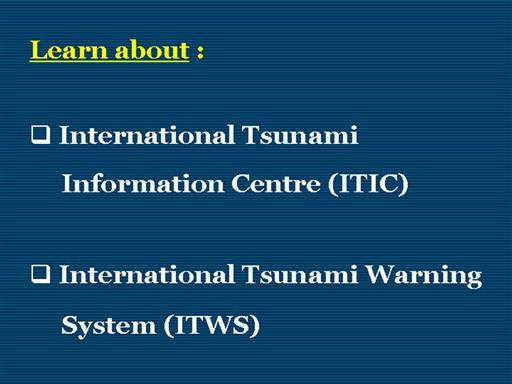| front |1 |2 |3 |4 |5 |6 |7 |8 |9 |10 |11 |12 |13 |14 |15 |16 |17 |18 |19 |20 |21 |22 |23 |24 |25 |26 |27 |28 |29 |30 |31 |32 |33 |34 |35|36 |37 |38 |39 |40 |41 |42 |43 |44 |45 |46 |47 |48 |49 |50 |51 |52 |53 |54 |55 |56 |57 |58 |59 |60 |61 |review |
 |
ITIC has played a significant role in coordinating cooperation among nations in the ITWS and establishing communication requirements, procedures, and monitoring the results.
§
“The great destruction and loss of life caused by the May 1960 Chilean tsunami prompted a large number of countries and territories to inquire about joining in a Pacific Tsunami Warning System (TWS).
The great Alaskan earthquake of 1964 generated another devastating tsunami that affected a good part of the Pacific. This tsunami disaster focused additional attention to the need for an International Tsunami Warning System under the auspices of a United Nations organization.
§
In 1965, UNESCO/IOC, recognizing the importance of providing timely warnings of the approach of potentially-catastrophic tsunamis in the Pacific Ocean, accepted the offer of the United States of America to undertake the expansion of its existing National Tsunami Warning Center in Honolulu, Hawaii, to become the International Tsunami Information Centre (ITIC).
§
The U.S.
Tsunami Warning Center in Honolulu, Hawaii (PTWC) became the headquarters of
the International Pacific Tsunami Warning System. At the same time,
UNESCO/IOC, accepted the generous offers of other UNESCO/IOC member
countries to integrate their existing facilities and communications into
this System. The existing U.S. Warning Systems in Hawaii and in Alaska
(ATWC) were integrated with the Systems of Japan, USSR, Chile, and of other
regional centers, and became a truly International Tsunami Warning System
(ITWS).” Citation source: http://www.drgeorgepc.com/TsunamiFAQ.html |